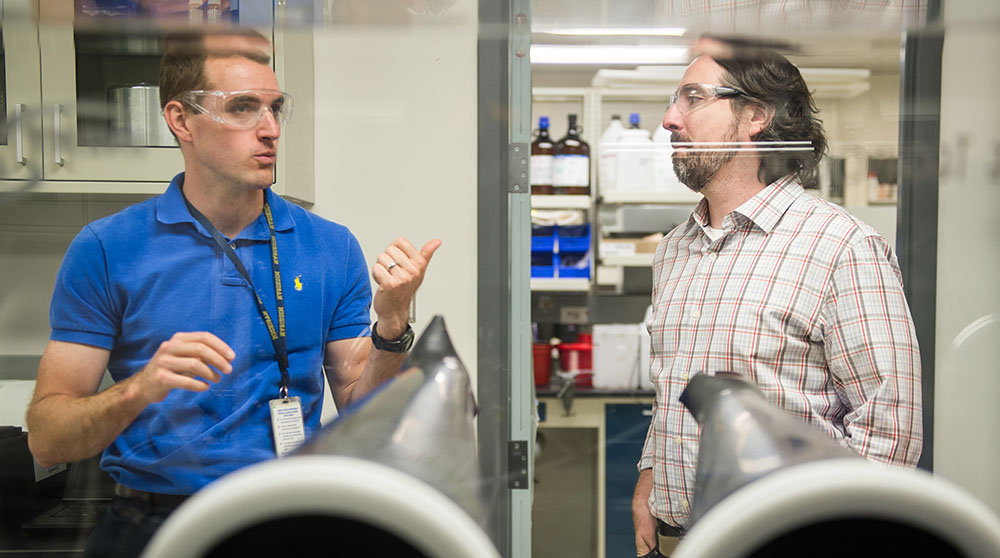Catalyst Scientist Dan Ruddy Is the New Director of ChemCatBio
At the Helm, Ruddy Will Support Current Research Initiatives and Guide Consortium Activities Amid Evolving Priorities

After directing the consortium for 8 years, NREL scientist Joshua Schaidle (left) is stepping down and NREL’s Daniel Ruddy (right) is stepping up as director. Photo by Dennis Schroeder, NREL
Since its beginning in 2016, the U.S. Department of Energy (DOE) Chemical Catalysis for Bioenergy Consortium (ChemCatBio) has paired national laboratory expertise with industry partners to help accelerate the development of catalytic technologies for bioenergy applications. Sitting on the board of directors and later as director during those foundational years, National Renewable Energy Laboratory (NREL) researcher Josh Schaidle was critical to organizing and supporting that collaborative mission.
Other senior scientists were there at the beginning, too—including NREL’s Daniel Ruddy, who sat on the steering committee with others from across the national laboratory system. In 2022, Ruddy become deputy director of the consortium, which benefited from his business development experience and expertise in the catalytic conversion of syngas, methanol, and carbon dioxide to fuels and chemicals—both critical for aligning consortium efforts with priorities of DOE’s Bioenergy Technologies Office (BETO).
Now, Ruddy will take on an even more influential role as director of the consortium—after Schaidle stepped down from leadership after 8 years of service.
"I am excited for this transition as I know Dan will take the consortium to new heights," Schaidle said.
ChemCatBio is in the middle of a 3-year funding cycle, and Ruddy said he aims to help the consortium deliver on its research and development focuses, which include working with engineered catalysts, realistic feed streams, and generating liquid products at quantities suitable for fuel property analysis. In the next phase of research, Ruddy wants the consortium to capitalize on opportunities to innovate new catalytic pathways to access fuel and chemical products.
"BETO recognizes that chemical coproducts bring value to the fuel-focused conversion pathways we’re developing, easing economic hurdles to adoption," Ruddy said. "ChemCatBio will use its breadth of expertise across a variety of chemistries, and its agility to pivot, as well as identify and explore production routes to valuable coproducts."
Josh Schaidle is shifting his focus to another leadership role at NREL, including managing research funded by DOE’s Office of Fossil Energy and Carbon Management.
During his tenure, Schaidle advanced key R&D priorities in collaboration with BETO technology managers. This included advancing multiple early-stage technologies to the point of commercial adoption by addressing critical technological risks. His leadership enabled the consortium to receive over $30 million in follow-on funding through 2022.
Schaidle has also been instrumental in positioning the consortium as a thought leader and central hub of knowledge at the intersection of catalysis and bioenergy. Today, ChemCatBio has a combined h-index of 53, with over 180 publications. It has hosted 13 public webinars. And the consortium maintains strong partnerships across industry, academia, and the national laboratories, exemplified by the more than 150 individuals who have directly contributed to the consortium’s success.
In short, ChemCatBio has become a pillar of the bioenergy community, and Ruddy said that legacy will continue.
"The consortium will still act as a central hub of knowledge for the bioenergy community," he explained. "We hope to act as an evaluator and developer of early-stage technologies for future impact."